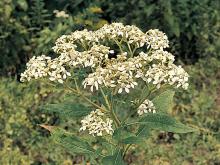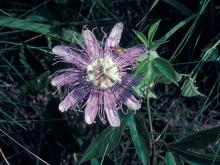Wildflowers, Grasses and Other Nonwoody Plants
Media

Species Types
Scientific Name
Packera obovata (formerly Senecio obovatus)
Description
Most common in the Ozarks, round-leaved groundsel is one of seven Packera species in our state. Its showy, bright yellow, daisylike flowers form flat-topped clusters that arise from sparsely leaved stems.
Media

Species Types
Scientific Name
Pyrrhopappus carolinianus
Description
One of several native plants called dandelions, Carolina false dandelion is an annual with sulphur yellow flowers and puffy seedheads.
Media

Species Types
Scientific Name
Heterotheca camporum (syn. Chrysopsis villosa var. camporum)
Description
Golden aster can cover entire valleys with its bright yellow flowers. It blooms June through October and is scattered mostly south of the Missouri River.
Media

Species Types
Scientific Name
Oenothera biennis
Description
True to its name, common evening primrose is the most common and widespread evening primrose in Missouri. It is most noticeable late in the season, when it reaches its greatest height and the flowers at the top are most visible.
Media

Species Types
Scientific Name
Oxalis stricta
Description
Yellow wood sorrel is both a garden weed and a wild edible. It has a pleasant sour taste, which is why some people call it sourgrass and add it to salads.
Media

Species Types
Scientific Name
Typha spp.
Description
Missouri’s cattails are all tall wetland plants with narrow, upright leaves emerging from a thick base, and a central stalk bearing a brown, sausage-shaped flower spike.
Media

Species Types
Scientific Name
Lilium michiganense
Description
This native lily looks a lot like the Asian “tiger lily” that is commonly cultivated in gardens. Michigan lily, however, has leaves mostly in whorls and lacks the round “bulblets” that tiger lily forms in its leaf axils.
Media

Species Types
Scientific Name
Verbesina virginica
Description
White crownbeard is a tall native perennial wildflower with clusters of white flowerheads. It's called “wingstem” for the narrow green wings running along the stem. It’s called “frostweed” because it forms "frost flowers": strange and beautiful formations at the stem bases after a sudden hard frost.
Media

Species Types
Scientific Name
Passiflora incarnata
Description
The bizarre, complicated flowers attract attention! The fruits are edible. Passion flower is a nonwoody vine that climbs via tendrils on trees or other structures. It is native to the southeastern United States, including southern Missouri.
Media

Species Types
Scientific Name
Fallopia japonica
Description
One of the worst invasive species in the world, Japanese knotweed can thrive in many places and can even damage foundations of buildings — not to mention the harm it causes in natural habitats. Learn to recognize it so you can prevent its spread.
See Also
About Wildflowers, Grasses and Other Nonwoody Plants in Missouri
A very simple way of thinking about the green world is to divide the vascular plants into two groups: woody and nonwoody (or herbaceous). But this is an artificial division; many plant families include some species that are woody and some that are not. The diversity of nonwoody vascular plants is staggering! Think of all the ferns, grasses, sedges, lilies, peas, sunflowers, nightshades, milkweeds, mustards, mints, and mallows — weeds and wildflowers — and many more!





















